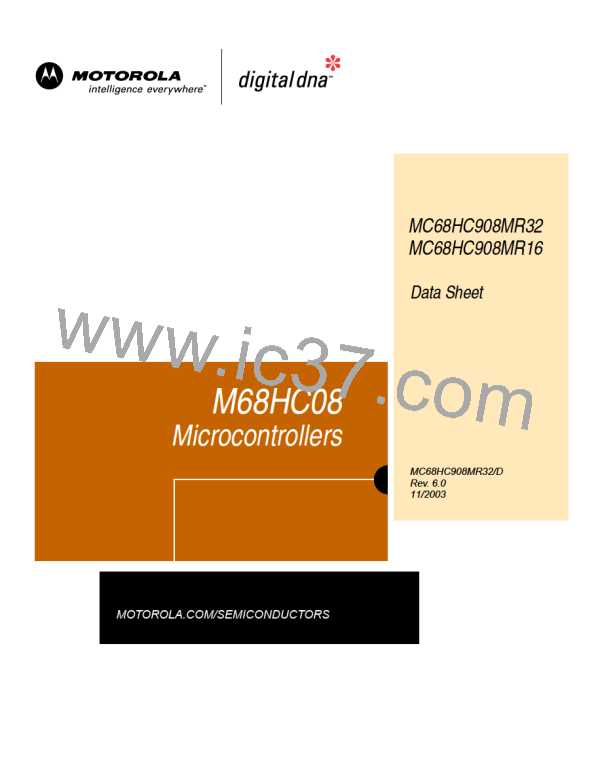Development Support
18.3.1.8 Baud Rate
With a 4.9152-MHz crystal and the PTC2 pin at logic 1 during reset, data is
transferred between the monitor and host at 4800 baud. If the PTC2 pin is at logic
0 during reset, the monitor baud rate is 9600. See Table 18-9.
Table 18-9. Monitor Baud Rate Selection
VCO Frequency Multiplier (N)
1
2
3
4
5
6
Monitor baud rate
4800
9600
14,400
19,200
24,000
28,800
18.3.2 Security
A security feature discourages unauthorized reading of FLASH locations while in
monitor mode. The host can bypass the security feature at monitor mode entry by
sending eight security bytes that match the bytes at locations $FFF6–$FFFD.
Locations $FFF6–$FFFD contain user-defined data.
NOTE:
Do not leave locations $FFF6–$FFFD blank. For security reasons, program
locations $FFF6–$FFFD even if they are not used for vectors.
During monitor mode entry, the MCU waits after the power-on reset for the host to
send the eight security bytes on pin PTA0. If the received bytes match those at
locations $FFF6–$FFFD, the host bypasses the security feature and can read all
FLASH locations and execute code from FLASH. Security remains bypassed until
a power-on reset occurs. If the reset was not a power-on reset, security remains
bypassed and security code entry is not required. (See Figure 18-13.)
Upon power-on reset, if the received bytes of the security code do not match the
data at locations $FFF6–$FFFD, the host fails to bypass the security feature. The
MCU remains in monitor mode, but reading a FLASH location returns an invalid
value and trying to execute code from FLASH causes an illegal address reset. After
receiving the eight security bytes from the host, the MCU transmits a break
character, signifying that it is ready to receive a command.
NOTE:
The MCU does not transmit a break character until after the host sends the eight
security bytes.
To determine whether the security code entered is correct, check to see if bit 6 of
RAM address $60 is set. If it is, then the correct security code has been entered
and FLASH can be accessed.
If the security sequence fails, the device can be reset (via power-pin reset only) and
brought up in monitor mode to attempt another entry. After failing the security
sequence, the FLASH mode can also be bulk erased by executing an erase routine
that was downloaded into internal RAM. The bulk erase operation clears the
security code locations so that all eight security bytes become $FF.
Data Sheet
286
MC68HC908MR32 • MC68HC908MR16 — Rev. 6.0
Development Support
MOTOROLA

 FREESCALE [ Freescale ]
FREESCALE [ Freescale ]